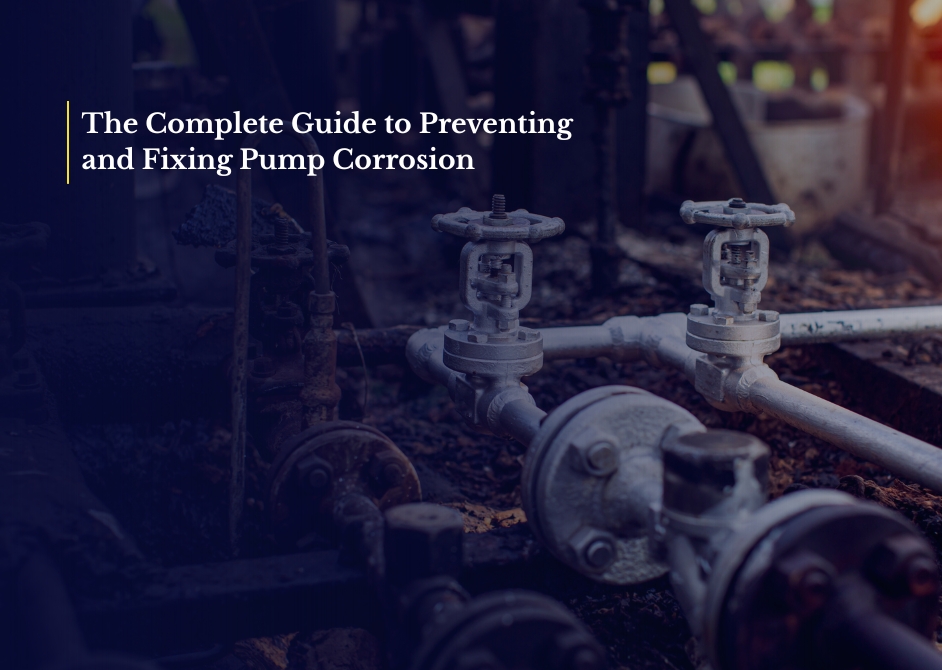Every year, pump corrosion drains over US $2.5 trillion from the global economy, roughly 3.4 % of global GDP, and that doesn't even capture the real-time costs, the unplanned downtime when pumps fail mid-operation, the rush orders for replacement parts, or the cascading production delays.
Corrosion isn’t a dramatic event. It creeps in quietly, layer by layer, until efficiency drops, leaks appear, or components seize.
This guide reveals how and why pumps corrode, teaches you what early warning signs to watch for, and lays out effective approaches to keep your pumps running reliably for years.
Key Takeaways
- Pump corrosion is a gradual process that often goes unnoticed until performance drops or failures occur.
- Environmental conditions, material compatibility, and maintenance practices are the main drivers of corrosion.
- Early detection tools like corrosion probes and ultrasonic testing help spot problems before they escalate.
- Choosing the right pump materials for the operating environment greatly extends service life.
- Knowing when to repair versus replace prevents wasted spend on short-term fixes.
- Proactive monitoring and expert input often deliver bigger long-term savings than post-failure repairs.
Understanding Pump Corrosion
Think of pump corrosion like a slow, invisible leak in your operations budget, except instead of money, it’s metal disappearing atom by atom. At its core, corrosion is a chemical reaction where metal atoms lose electrons to oxygen or other agents in the fluid, forming oxides or other compounds that weaken the structure.
Pumps typically face four major corrosion types:
- Pitting: small but deep cavities that can perforate casings.
- Crevice corrosion: attack in tight gaps like gasket seats or under deposits.
- Galvanic corrosion: one metal sacrifices itself when paired with another.
- Erosion-corrosion: accelerated wear from high-velocity flow carrying abrasive particles.
Certain conditions speed up this damage: higher temperatures, elevated flow velocity, aggressive fluid chemistry, or dissimilar metals in contact. (More on this in the later section).
Real-world example: In a coastal desalination plant, a stainless-steel pump casing exposed to high chloride content can develop pitting within months.
Knowing which corrosion type you’re dealing with isn’t just academic; it determines whether you flush, coat, reline, or replace components, and ensures preventive measures target the right risk. Many failures still trace back to a handful of common, and often avoidable, causes.
Common Causes of Pump Corrosion
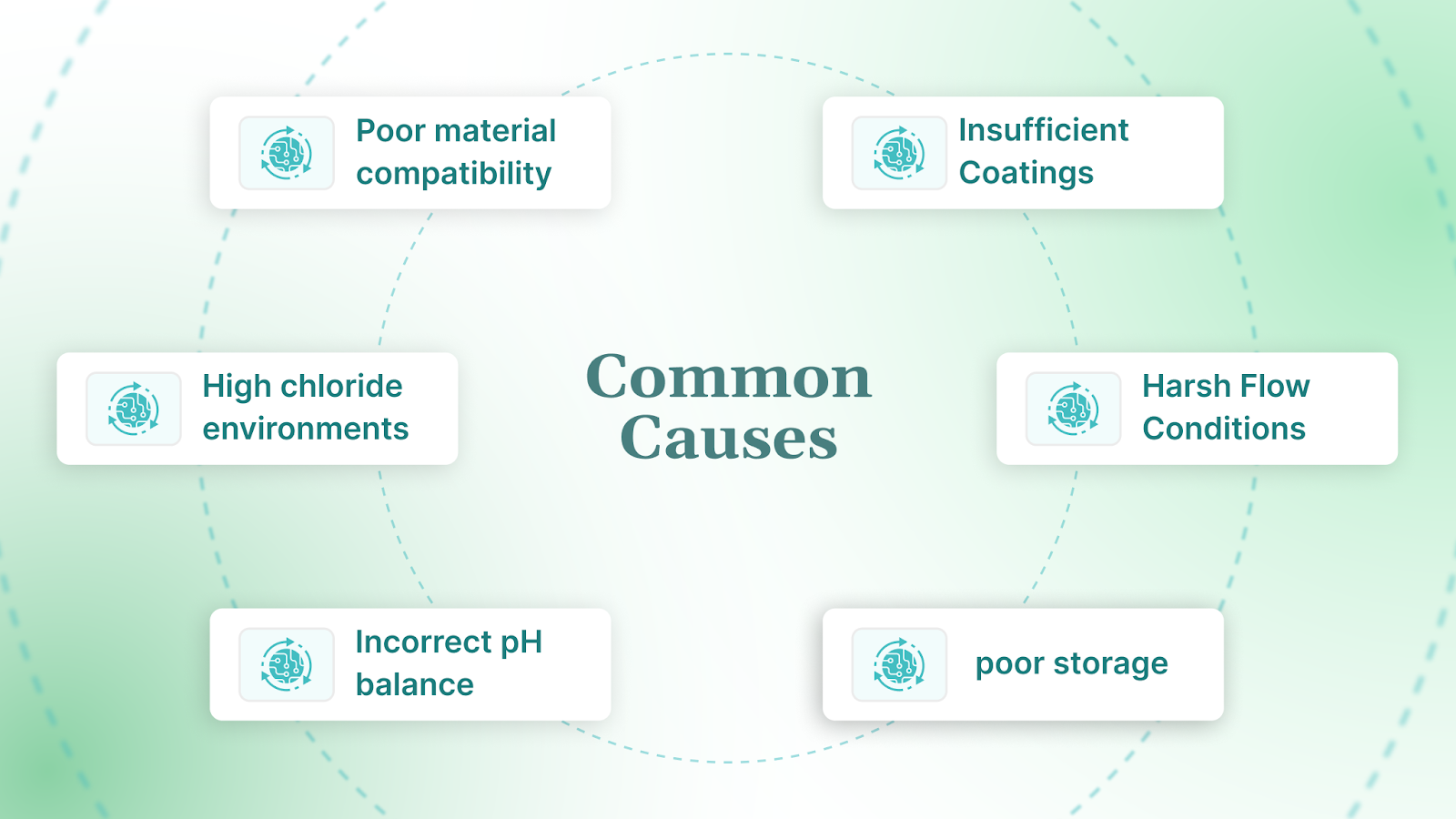
Even the best-engineered pumps can fail early if their environment works against them. These are some of the most frequent culprits and why they matter:
- Poor material compatibility: Pairing the wrong metal with the pumped fluid (e.g., cast iron in seawater) triggers rapid electrochemical breakdown. Over time, this mismatch accelerates pitting and structural loss.
- Inadequate protective coatings: Worn or improperly applied linings leave the underlying metal exposed. Once a breach forms, corrosion often spreads under the coating unseen.
- High chloride or acidic environments: Salts, acids, or low pH levels attack passive metal layers, especially in stainless steels, causing localized failures like crevice corrosion.
- Hard water, acidic media, high-temp flow, or high velocity: Abrasive particles and aggressive chemistry combine with physical wear, thinning metal surfaces faster than expected. High velocities, in particular, strip away protective films and create erosion-corrosion.
- Incorrect pH balance: Even small deviations from optimal pH can double corrosion rates, particularly in mixed-metal systems.
- Infrequent maintenance or poor storage: Idle pumps often develop condensation or deposits that begin the corrosion process long before operation resumes.
Conditions That Accelerate Damage
Several environmental and operational factors act as corrosion multipliers:
- Higher temperatures: Heat speeds up chemical reactions, meaning corrosion processes happen faster, especially in acidic or saline fluids.
- Elevated flow velocity: Turbulence increases erosion, exposing fresh metal to corrosion in a continuous cycle.
- Aggressive fluid chemistry: Fluids containing sulfides, chlorides, or low pH strip protective films and pit the surface.
- Dissimilar metals in contact: Creates galvanic cells where the less noble metal corrodes rapidly to protect the more noble one.
A food processing facility replaced the same pump every 18 months. Investigation revealed cleaning agents with low pH had stripped away its protective coating. Combined with elevated water temperatures during cleaning cycles, the corrosion rate doubled, something that could have been prevented with a material upgrade and pH control.
That’s where early detection steps in, spotting a problem while it’s still a quick fix, long before it starts eating into your budget.
Detecting and Preventing Pump Corrosion: A Two-Step Defense
The most cost-effective way to fight corrosion isn’t scrambling after a breakdown it’s spotting trouble early and stopping it from coming back. Think of it as a two-step defense: first, identify warning signs before they’re visible, then act to keep corrosion from gaining ground again.
Part 1: Detecting Corrosion Early
- Corrosion coupons & probes: Coupons sit inside the system and are checked at set intervals, giving a real-world corrosion rate based on your exact operating conditions. Probes take it a step further with continuous, real-time readings, especially valuable in aggressive environments like brine or acidic slurries.
- Ultrasonic wall thickness testing: Perfect for finding hidden thinning in areas like pump volutes or behind impellers. In one wastewater facility, annual ultrasonic scans caught wear two years before leaks, avoiding a mid-season shutdown.
- Vibration sensors: Corrosion can weaken pump internals, changing how they vibrate under load. A sudden shift in vibration data often points to internal damage well before visible symptoms appear.
- Visual inspections with reference galleries: A trained eye, paired with photographic comparison charts, helps spot early pitting, scale build-up, or discoloration patterns that signal corrosion in its early stages.
Many failures that are blamed on “sudden” corrosion develop over months. Early detection means repairs can be surgical, targeted coating, part swaps, rather than full pump replacements.
Part 2: Preventive Practices
- Regular flushing: Prevents deposits from creating micro-environments where corrosion thrives, especially in slurry or seawater systems.
- Upgrading wetted parts: Switching to duplex stainless steel, superalloys, or composites in high-chloride or acidic service drastically slows degradation.
- Protective coatings/linings: Epoxy, ceramic, or polymer linings form a barrier between the fluid and the base metal. For maximum lifespan, reapply coatings at the first sign of wear rather than after full failure.
- pH & water chemistry management: Frequent testing and adjustment keep the environment neutral, slowing both general and localized corrosion.
- Filtration systems: Removing abrasive solids protects surfaces from erosion-corrosion and also reduces the chemical attack rate.
Field Insight: Detection and prevention go hand in hand. If an ultrasonic scan shows wear in high-velocity areas, that’s your opportunity to act by applying protective coatings or upgrading materials before the damage forces an unplanned shutdown. Involving experts at this stage can turn a costly future replacement into a planned, budgeted maintenance task.
What to Do When You’re Already Corroded
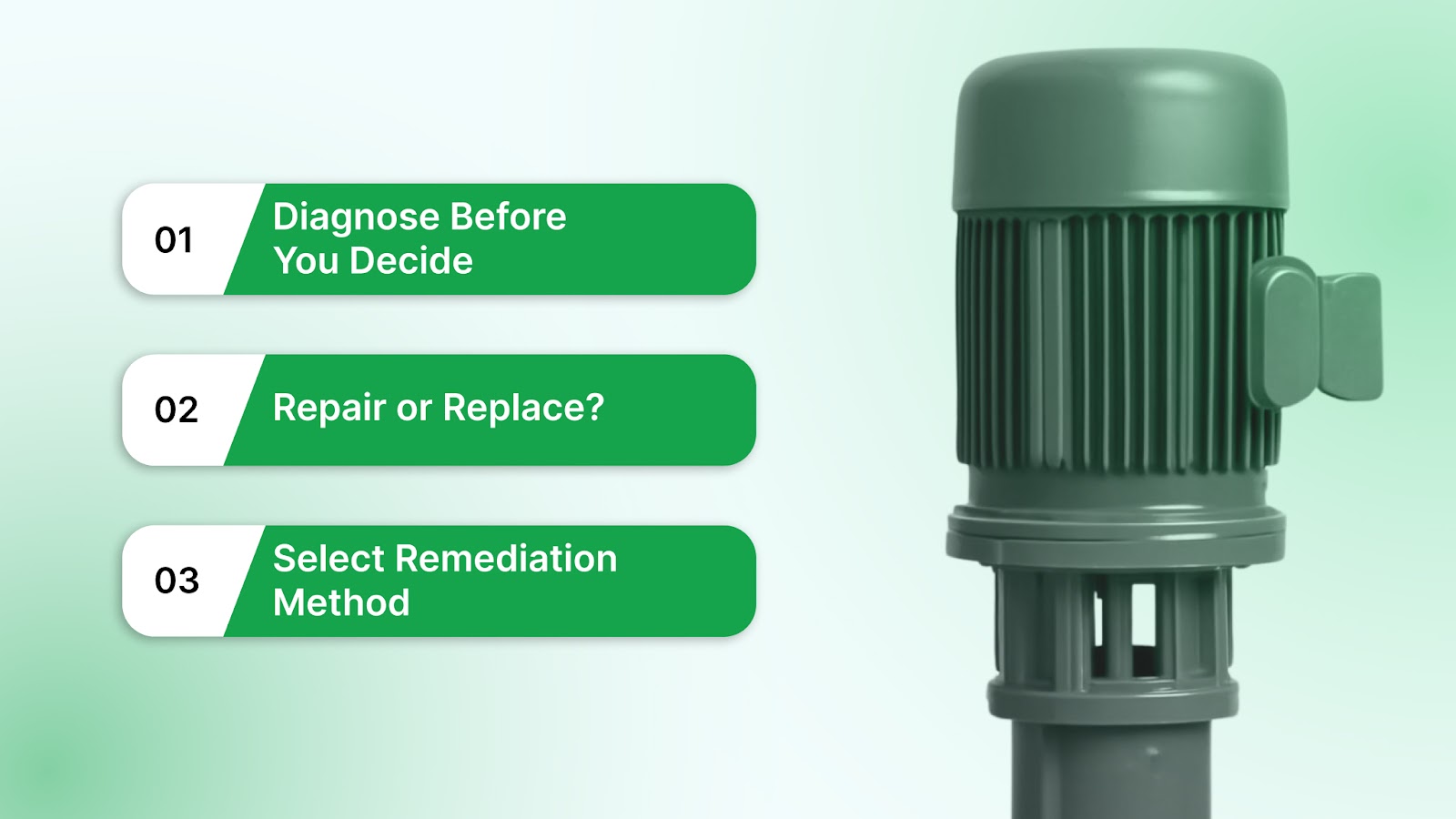
When corrosion has already set in, the costliest mistake is jumping straight into a fix without a full picture of the damage. A methodical approach ensures you invest in a solution that lasts rather than patching the same problem every few months.
1. Diagnose Before You Decide
A thorough assessment is the foundation for any repair or replacement decision:
- Internal inspections & surveys: Use borescopes or partial disassembly to inspect hidden surfaces for pitting, scaling, or under-deposit corrosion.
- Thickness measurements: Ultrasonic testing or micrometer readings help determine remaining wall thickness. A reduction of more than 20% from the original spec is a strong warning sign.
- Operational history review: Flag recurring leaks, vibration spikes, temperature rises, or efficiency drops that suggest systemic issues rather than isolated damage.
Accurate diagnostics let you decide early whether to repair or replace, align work with scheduled maintenance windows, and avoid wasting budget on short-term fixes that lead to repeat shutdowns.
2. Repair or Replace?
Once you know the scope of the damage, weigh the decision on both technical and economic grounds:
Repair makes sense when:
- Wall thickness is still within safe limits.
- Corrosion is localized (e.g., confined to one casing section).
- Downtime for repair is shorter and less costly than replacement.
Replacement is the better choice when:
- Casing or impeller thickness is critically compromised.
- Failures recur despite previous interventions.
- Efficiency loss increases operating costs enough to offset the price of a new unit.
- Lifecycle cost analysis shows that 12–18 months of repair expenses can equal or exceed 60–70% of replacement cost, which means delaying the decision often costs more than replacing the pump outright.
3. Choosing the Right Remediation Method
If repair is the chosen path, match the method to the service conditions:
- Welding: Best for structural reinforcement of deep pits or cracks in low- to medium-corrosion environments.
- Epoxy patching: Quick and cost-effective for small leaks, though service life may drop to months in abrasive slurry applications without additional overlays.
- Coating re-application: Restores chemical resistance in aggressive environments, particularly where pH or chloride content is high.
- Relining: Installing a corrosion-resistant liner (rubber, polymer, or ceramic) offers long-term protection in severe-duty applications like mineral processing.
You can patch, reline, or replace, but even the best fix only resets the clock; it doesn’t make the pump immune to future corrosion. If the root causes aren’t addressed and the right materials and coatings aren’t in place, you’re on a countdown to the next failure.
That’s where working with a partner who understands both the chemistry and the mechanics of pump protection changes the game.
Partnering with Chemitek for Long-Term Reliability
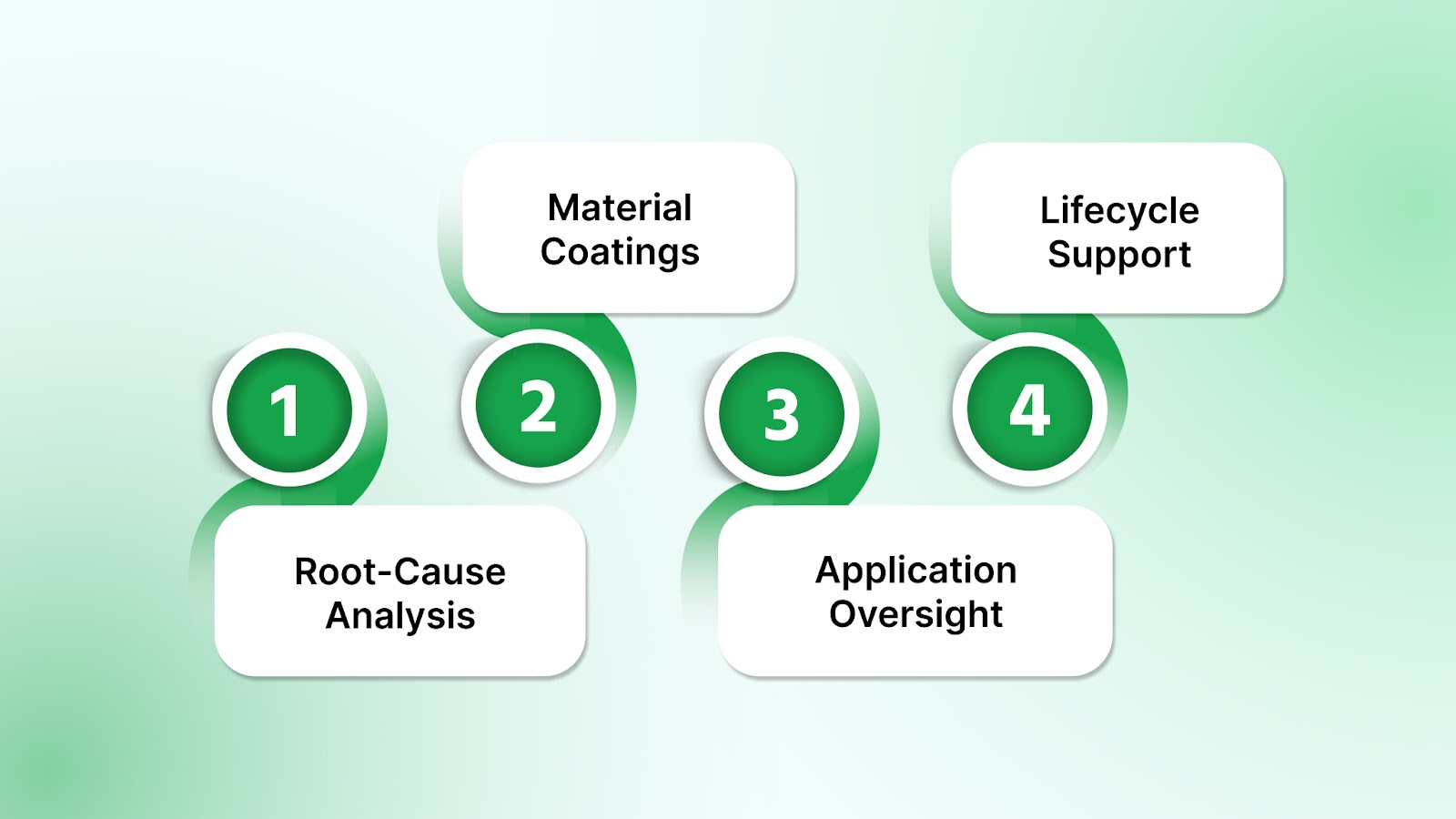
At Chemitek, we work with you to make the decisions with confidence, turning corrosion control from a recurring headache into a predictable, manageable part of your operations.
Because the less time you spend firefighting failures, the more time your pumps spend doing what they were built to do, keep your operations running.
Here’s how we help:
- Root-Cause Analysis: Using advanced testing and inspection tools, we identify exactly why corrosion started, so the solution addresses the source, not just the symptom.
- Material & Coating Recommendations: From duplex stainless steels to advanced polymer linings, we match the material to your fluid chemistry and operating conditions.
- Application Oversight: We make sure protective coatings and linings are applied to spec, eliminating weak points that often lead to premature failures.
- Lifecycle Support: We provide maintenance guidance and periodic inspections to keep pumps performing at peak efficiency for longer.
Whether you’re dealing with recurring pitting in seawater service, erosion-corrosion in slurry lines, or galvanic attack from mixed metals, we help turn reactive maintenance into a planned, predictable process, saving you both downtime and budget over the long run.
Conclusion
Corrosion might be inevitable, but costly downtime doesn’t have to be. By understanding the types and causes of pump corrosion, spotting the early warning signs, and applying targeted prevention strategies, you can keep your equipment running longer and more efficiently.
Treating corrosion control as part of your operational planning rather than a series of emergency repairs. Whether that means selecting the right alloys, managing fluid chemistry, or scheduling routine inspections, every step you take today reduces the risk of tomorrow’s breakdown.
And if you want that process to be data-driven, consistent, and cost-effective, partnering with specialists like Chemitek ensures your solutions aren’t just temporary fixes but long-term safeguards for your pumping systems.
Talk to our team at Chemitek to explore customized corrosion-resistant pump solutions, whether it’s selecting the right alloy, applying high-performance linings, or providing full lifecycle pump support, so your operations run reliably and without costly interruptions.
FAQs on Pump Corrosion and Maintenance
1. What is the most common cause of pump corrosion?
The most frequent cause is poor material compatibility using metals that react with the pumped fluid. For example, cast iron in seawater corrodes quickly due to electrochemical reactions. Other triggers include high chloride content, improper coatings, and aggressive fluid chemistry.
2. How can I tell if my pump is starting to corrode?
Look for early warning signs such as unusual vibration, drop in efficiency, surface pitting, or discoloration near wetted parts. Using tools like ultrasonic testing or corrosion probes can reveal damage long before it’s visible.
3. Is repairing a corroded pump always cheaper than replacing it?
Not necessarily. Lifecycle cost analysis often shows that repeated repairs can add up to 60–70% of the cost of a replacement within 12–18 months. If corrosion is widespread or the wall thickness is critically low, replacement may be the more cost-effective option.
4. How often should corrosion inspections be carried out?
For pumps operating in aggressive environments such as those handling seawater, slurries, or acidic fluids, quarterly inspections are recommended. For less severe conditions, annual checks may be sufficient.
5. What’s the best way to prevent corrosion in pumps?
A multi-step approach works best:
- Choose the right material or coating for the application.
- Maintain optimal pH and water chemistry.
- Use filtration systems to remove abrasive particles.
- Implement a regular flushing and inspection schedule.
6. How can Chemitek help with corrosion problems?
At Chemitek, we work with you to identify the root cause of corrosion, recommend the right materials or coatings, and ensure proper application and lifecycle support. This turns corrosion control into a predictable, manageable process rather than a recurring emergency.
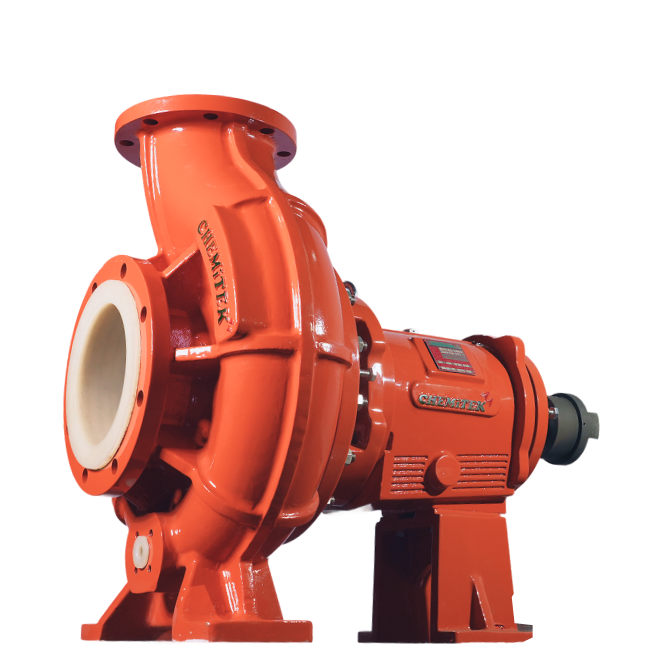
Latest posts
Ready to Upgrade Your Process Operations?
